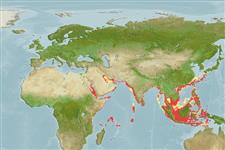Common names from other countries
分類 / Names
共通名の | 類義語 | Catalog of Fishes(部類, 種) | ITIS | CoL | WoRMS | Cloffa
>
Eupercaria/misc (Various families in series Eupercaria) >
Nemipteridae (Threadfin breams, Whiptail breams)
Etymology: Nemipterus: Greek, nema, -atos = filament + Greek, pteron = wing, fin (Ref. 45335).
More on author: Bloch.
Environment: milieu / climate zone / depth range / distribution range
生態学
海 底生の; 移住性ではない; 深さの範囲 5 - 80 m (Ref. 9785). Tropical; 34°N - 11°S, 31°E - 133°E (Ref. 3810)
Indo-Pacific.
Length at first maturity / サイズ / 重さ / 年齢
Maturity: Lm 18.3 range ? - ? cm
Max length : 34.0 cm TL オス/雌雄の選別がない; (Ref. 124816); common length : 25.0 cm TL オス/雌雄の選別がない; (Ref. 5450); 最大公表体重: 596.00 g (Ref. 1448); 最大記録サイズ: 8 年 (Ref. 1448)
背面の脊椎 (合計) : 10; 背鰭 (合計) : 9; 肛門の骨: 3; 臀鰭: 7. This species is distinguished by the following characters: lower margin of eye above a line from tip of snout to upper base of pectoral fins; a line drawn up from the posterior edge of suborbital reaching the dorsal profile 2 to 4 scale rows before origin of dorsal fin; pectoral fins very long, 1-1.3 in HL, reaching to or just beyond level of origin of anal fin; pelvic fins moderately long, 1.2-1.6 in HL, reaching to or just beyond anus; caudal fin moderately forked, upper lobe slightly longer than lower and produced into a short or moderately long filament. Colour: upper part of body pinkish, becoming silvery below; top of head behind eye with a golden sheen; 11-12 pale golden-yellow stripes along body from behind head to base of caudal fin; a prominent red-suffused yellow blotch below origin of lateral line; dorsal fin whitish, margin of fin yellow, edged with red; a pale lemon stripe near base of dorsal fin, this stripe narrow anteriorly and widening on posterior part of fin; anal fin whitish with pale lemon broken lines or scribblings over most of fin; caudal fin pink, upper tip and filament yellow (Ref. 9785).
Very abundant in coastal waters, found on mud or sand bottoms, usually in schools. Feeds mainly on small fishes, crustaceans, mollusks (mainly cephalopods), polychaetes and echinoderms. Marketed mainly fresh, but also frozen, steamed, dried-salted, dry-smoked, fermented or made into fish balls and fish meal.
Females predominate at small sizes and males at larger sizes, due to faster growth rate in males (Ref. 6254).
Russell, B.C., 1990. FAO Species Catalogue. Vol. 12. Nemipterid fishes of the world. (Threadfin breams, whiptail breams, monocle breams, dwarf monocle breams, and coral breams). Family Nemipteridae. An annotated and illustrated catalogue of nemipterid species known to date. FAO Fish. Synop. 125(12):149p. Rome: FAO. (Ref. 3810)
CITES (Ref. 128078)
Not Evaluated
Human uses
水産業: 商業
用具
特記事項
XMLをダウンロードして下さい
インターネットの情報源
Estimates based on models
Preferred temperature (Ref.
115969): 24.7 - 29.2, mean 28.4 (based on 1310 cells).
Phylogenetic diversity index (Ref.
82804): PD
50 = 0.5000 [Uniqueness, from 0.5 = low to 2.0 = high].
Bayesian length-weight: a=0.01413 (0.01228 - 0.01625), b=2.95 (2.92 - 2.98), in cm Total Length, based on LWR estimates for this species (Ref.
93245).
栄養段階 (Ref.
69278): 4.2 ±0.81 se; based on food items.
回復力 (Ref.
120179): 手段, 1.4年~4.4年の倍増期間の最小個体群 (K=0.29-1.06; tm= 0.5-1.4; tmax=8; Fec = 13,900).
Prior r = 0.58, 95% CL = 0.38 - 0.86, Based on 1 full stock assessment.
Fishing Vulnerability (Ref.
59153): Low vulnerability (21 of 100).
Climate Vulnerability (Ref.
125649): High vulnerability (57 of 100).
